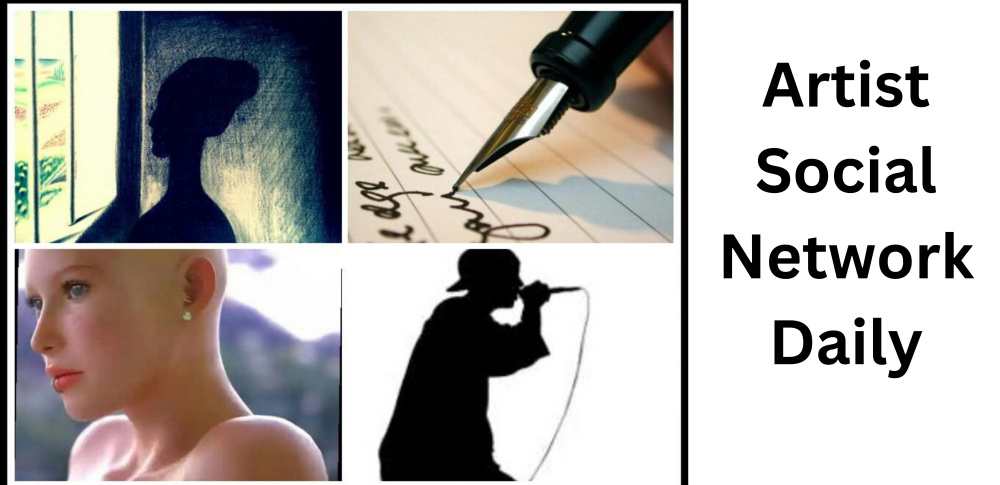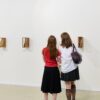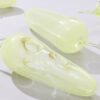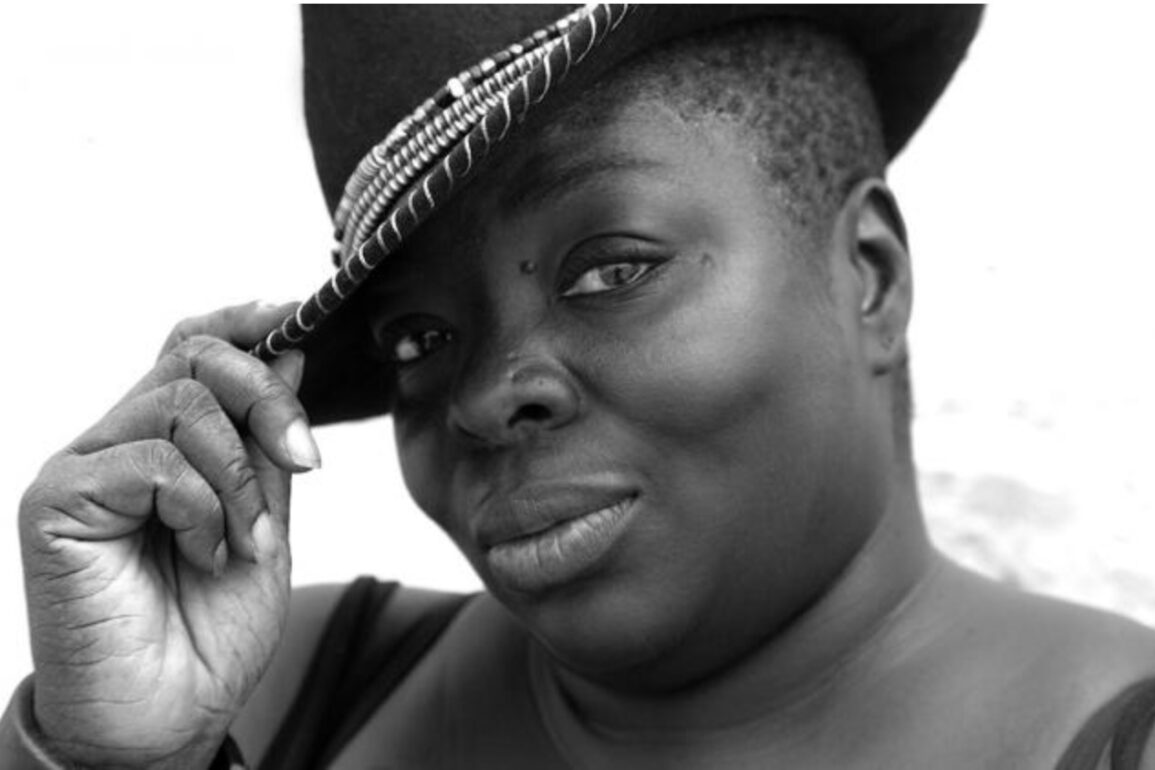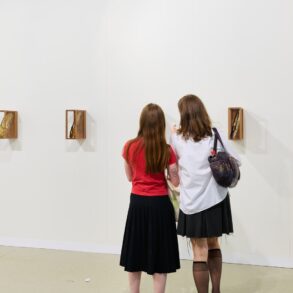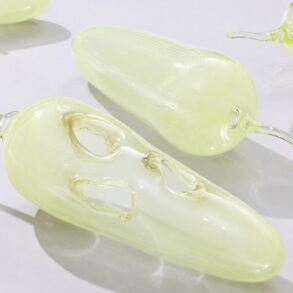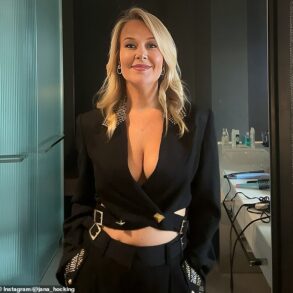Nona Faustine (1977-2025). | Photo by Grace Roselli and Pandora’s BoxX Project, Courtesy the artist
“I turned the lens on myself,… because I felt that the lives of Black women get very little exposure.” — Nona Faustine
ARTIST AND PHOTOGRAPHER Nona Faustine (1977-2025), whose powerful practice was centered around identity, history, trauma, lineage, and representation, died on March 20 at the age of 48. News of Faustine’s death was confirmed by her gallery, Higher Pictures in Brooklyn, N.Y., with no cause of death cited.
On March 31, the artist’s family disclosed that she died after a five-year battle with cancer. On Instagram, Faustine’s sister Channon Simmons called her “a singular force of nature.” Simmons wrote that she identified herself chiefly as an artist and mother and “will forever be remembered for her sharp wit, infectious laughter punctuated by her striking looks and what my mother called her 1,000 watt smile.”
Faustine made images of young mothers, the women in her family, and was critically recognized for her self portraiture. “Once I turned the lens on myself, I examined and photographed everything around me because I felt that the lives of Black women get very little exposure. The true lives of Black women in the United States, if not in the world, are not seen,” Faustine told BOMB magazine last year in an interview conducted by Carla J. Williams. “I wanted to show our lives and who we are. We are very special. Not just because of our suffering but because of our beauty and strength.”
Faustine shined a rare light on the history of the transatlantic slave trade in New York. She was best known for her White Shoes series, which blends self portraiture and landscape photography. The artist documented herself standing at sites around New York City associated with the legacies of enslavement, including burial grounds; Lefferts House in Brooklyn, where enslaved persons lived; and Wall Street, where a slave market opened in 1711.
In the images, Faustine is often nude or partially clothed, wearing white pumps. The sensible shoes are a metaphor for the oppressive experiences of Black and Indigenous peoples, from colonialism to assimilation. Last year, the Brooklyn Museum presented “Nona Faustine: White Shoes,” the artist’s first solo museum exhibition.
“White Shoes is not just about slavery and suffering and sorrow,” Faustine said in the BOMB interview. “Showing my body in that way, I go through stages. You see me on Wall Street on that slave block, but you also see me in other places where I am powerful and my nudity is like armor. I’m confronting you with this big fleshy body, and it is something to be celebrated—a body that carried a child, a body that gave birth, a body that is feminine, and a body that is joy.”
“White Shoes is not just about slavery and suffering and sorrow. Showing my body in that way, I go through stages. You see me on Wall Street on that slave block, but you also see me in other places where I am powerful and my nudity is like armor.” — Nona Faustine
NONA FAUSTINE, From White Shoes: “There are few markers left but your black body is the marker. The land does hold the memory of your existence. You only have to put it there in its natural state to remember. — Harriet Tubman, Sylvester Manor, Shelter Island, NY,” 2021. | ©The Estate of Nona Faustine, Courtesy the artist and Higher Pictures
FAUSTINE WAS BORN AND RAISED in Brooklyn, where she continued to live and practice. Her parents were both from North Carolina. Growing up, she was exposed to photography by her father and uncle, who “were camera and picture enthusiasts.” She further explained to BOMB: “My uncle and father were the ones who put the camera in my hand and introduced me to photography; it was just natural that I had this affinity for the camera and pictures.”
The family photo album filled with images of relatives and ancestors in the North and South was a precious object in the home. It was years before Faustine realized her mother took pictures, too. It was her mother who shot her baby photos and captured the key experiences and milestone moments of Faustine and her younger sister (Simmons) as they were coming of age, not her father, as she had assumed.
“When I came to a point in my life where I was giving up on the idea of being a photographer, my mother was the one who pushed me,” Faustine told BOMB. Her sister urged her to do the same.
On Instagram, Simmons said: “Nona fiercely prioritized our family and focused on the quality of our lives, crediting my mother, Queen Elizabeth and myself with making everything possible through our love and support. And it was our honor to do so.”
Faustine focused on street photography and documentary photography at the School of Visual Arts in New York, where she earned a BFA in photography (1994). Nearly a decade later, she sought to further her education. Faustine wrote about this time in her life and some of the challenges she faced for the Leslie-Lohman Museum of Art in New York. In an essay titled “Intersectionality in the Studio,” she wrote:
-
Entering graduate school I was an unemployed, single mother with a toddler receiving public assistance. When employees at New York’s Human Resources Administration (HRA) found out I was in a MFA program they looked at me like I was crazy. “You can’t be on public assistance and be in a MFA program.” I sacrificed everything to pursue my degree. I took out huge student loans to pay tuition and to live. I was lucky enough to have a mother and a sister who believed in me; they pushed me to return to school and return to photography. “Get that degree woman.” “Don’t let your talent go to waste,” they told me.
By 2013, when Faustine completed her MFA at the International Center of Photography at Bard College, she had honed the focus of her practice and already embarked upon the White Shoes project. In the ensuing dozen years, Faustine received local, national, and international recognition, and an array of opportunities.
NONA FAUSTINE (born Brooklyn, NY, 1977), From White Shoes: “They Tagged the Land with Trophies and Institutions from Their Rapes and Conquests, Tweed Courthouse, NYC,” 2013 (Pigment print, 50 × 60 inches / 127 × 152.4 cm). | Courtesy of the artist and Higher Pictures. © Nona Faustine
Nona Faustine’s My Country series “confronted and interrogated iconic American monuments, such as the Lincoln Memorial and the Statue of Liberty. Faustine used her camera to reframe conventional, colonialist perspectives, and reinserted some of the truth and trauma behind these memorialized spaces.” Shown, From My Country: NONA FAUSTINE, “Liberty or Death, Sons of Africa,” 2019 (silkscreen, 40 x 60 inches) Edition of 20. | © Nona Faustine, Published by Two Palms
She was a 2016 Workspace Resident at Baxter St at the Camera Club of New York, where her solo exhibition featured a photographic series called, “My Country.” The images of iconic national monuments, such as the Lincoln Memorial, Washington Monument, and the Statue of Liberty, reframe and obstruct views of the sites, symbolically challenging accepted narratives of America’s problematic history. (A few years later, Faustine produced the My Country images in a series of silkscreen prints with Two Palms.)
In 2019, Faustine received a $25,000 Anonymous Was a Woman grant, an award designed to support women artists “over 40 years of age and at a significant juncture in their lives or careers, to continue to grow and pursue their work.” The same year, she was a finalist in the 2019 Outwin Boochever Portrait Competition at the Smithsonian’s National Portrait Gallery.
Kehinde Wiley’s Black Rock Senegal residency program included Faustine in its inaugural class of artists (2019-20), giving her an opportunity to spend time in West Africa and view her practice through a new lens. In 2022, Faustine was an artist in residence at Light Work. Located in Syracuse, N.Y., Light Work is a nonprofit whose mission is “to provide direct support to emerging and under-recognized visual artists working in photography and related lens based media through artist residencies, exhibitions, projects, and publications.”
More recently, Faustine was a 2024-25 Rome Prize Fellow. She was awarded the Joseph H. Hazen Rome Prize from the American Academy in Rome. When Faustine died, the Academy issued a statement, memorializing the artist and sharing some of her experiences in Italy, where she arrived in September 2024, accompanied by her daughter, Queen Ming.
“From the beginning, she embraced Rome with openness, awe, and the keen visual intelligence that shaped her practice. She often spoke of how meaningful it was to experience the city—and the Academy—with Queen by her side,” the Academy reported.
“During her three months at the Academy, Nona immersed herself in Rome’s architectural and historical textures. Her work examined the visual languages of monuments and empire, reframing them through a personal and political lens. She shared meals with fellows and residents, contributed generously to discussions, and exhibited her work in the Academy’s fall exhibition, ‘Artists Making Books: Pages of Refuge.’ Her presence on the campus was powerful—clear-eyed, warm, and deeply grounded.”
When Faustine returned home, the Academy said she stayed in touch. In one of her last messages, she said: “The Academy opened up a whole new world for me.”
Nona Faustine was a finalist in the 2019 Outwin Boochever Portrait Competition at the Smithsonian’s National Portrait Gallery in Washington, D.C. She submitted this photograph: NONA FAUSTINE, From White Shoes: “Isabelle, Lefferts House, Brooklyn (Self-Portrait),” 2016 (inkjet print). | © Nona Faustine, Collection of the artist
NONA FAUSTINE, From Mitochondria Series: “The Two Queens,” 2011. | © The Estate of Nona Faustine, Courtesy the artist and Higher Pictures
IN 2019, FAUSTINE photographed artist Faith Ringgold (1930-2024) at her home in Englewood, N.J., for Cultured magazine. She captured Ringgold wearing a garment of her own design, a gown composed of an array of fabrics in a variety of patterns. Ringgold looks incredibly regal in the portrait, sitting outside, her chair positioned on the lawn, with a wooded landscape in the background. When Ringgold died last year at the age of 93, Faustine marveled at the experience. On Instagram, she said she was grateful to meet Ringgold, spend time with her, and hear her stories.
Faustine held the women artists who came before her in high regard and appreciated the path they paved for new generations. Williams, who interviewed Faustine for BOMB, is a photographer, writer, and editor. Born in 1965, she is only about 12 years older than Faustine.
In the introduction to their conversation, Williams wrote: “We aren’t the only two Black women photographers who make self-portraits, nor are we the only ones to photograph our nude bodies, but in Faustine I see what fueled my work: fearlessness. It is clear in that early work that she fundamentally knew her worth—her strength, physicality, and confidence—and dared to declare it photographically,” Both Williams and Faustine are on the roster at Higher Pictures.
When Williams began the conversation, she thanked Faustine for doing the interview. Faustine recipricated. “Thank you!” she said. “I’m indebted to you and all the women that came after you, on whose shoulders I stand and to whom I credit my success, because you all laid the foundation,” Faustine told Williams. “I know some of you were not given your flowers or your proper due or all the successes that you deserved. Hopefully seeing artists like me makes up for it a little bit.”
Faustine’s work is in the collections of the Studio Museum in Harlem; Museum of Modern Art in New York; David C. Driskell Center at the University of Maryland, College Park; Carnegie Museum of Art in Pittsburgh, Pa.; and the Los Angeles County Museum of Art (LACMA), among other institutions. “Maison des Esclaves, Door of No Return, Descendant Daughter Returns, Goree Island, Senegal” (2020), an image the artist made during her residency at Black Rock Senegal was acquired by LACMA and is currently on view at the museum in the exhibition “Imagining Black Diasporas: 21st-Century Art and Poetics.”
Installation view of “Nona Faustine,” Brooklyn Museum, Brooklyn, N.Y. (March 8-July 7, 2024). | Photo by Danny Perez, Paula Abreu Pita. Courtesy Brooklyn Museum
The Brooklyn Museum, Faustine’s hometown museum was particularly supportive. In 2018, following a series of feminist art exhibitions, the Brooklyn Museum announced the acquisition of nearly 100 works of art by women artists, including three photographs by Faustine. The self portraits—”Not Gone With The Wind, Lefferts House, Brooklyn,” “Lobbying the Gods For A Miracle, Brooklyn,” and “Isabelle, Lefferts House, Brooklyn,”—were produced in 2016. The latter work is the portrait Faustine submitted to the Smithsonian’s Outwin Boochever Portrait Competition.
“Nona Faustine: White Shoes,” the artist’s first solo museum exhibition, was on view at the Brooklyn Museum in 2024. Following Faustine’s death, the Brooklyn Museum posted a tribute to the artist on Instagram. “Her vulnerable and commanding work urges us to think critically about the hidden, often traumatic histories of the places we call home,” the museum said.
“White Shoes” showcased her most consequential body of work, displaying the series in its entirety for the first time, with more than 40 self portraits on view. In a video produced on the occasion of the Brooklyn Museum exhibition, Faustine explained her motivation for making the images:
-
What we were told about slavery in New York was that we freed our slaves very early. There was very little slavery here. You know, it was like as if it was like the utopia Free North. And it couldn’t be any further from the truth. We were one of the largest like slave holding northern states.
Brooklyn had the largest amount of slaves.
I wanted to do a series that talked about the history of New York slavery specifically, and women, myself. It was kind of, you know, autobiographical in that I’m a native New Yorker. I would go to all these places, different sites in New York City’s five boroughs and Long Island and really bring that history to life, the spaces that enslaved people worked. So it was like houses, you know, the early Dutch houses. It was plantations and it was even places where they were sold, like on Wall Street slave markets.
It also encompassed free African-Americans like Seneca Village (the site of what is now Central Park). It also included some of the sites of the Lenape Indians, like Borough Hall and on Shelter Island, where also First Nation people and African people were enslaved and worked.
What I’m reclaiming with my work in the White Shoe Series is the anonymous men and women and children who were sacrificed really, in the building of New York City and of this nation, and who made America just literally by their their bodies and labor, or superpower.
Faustine continued: “I feel a debt to these people. My people, they’re all, they’re our ancestors, literally. I feel like we owe it to them and to us to acknowledge what has happened here on this Earth, in this city. By doing that, we say their name, We say where they lived and died and buried and worked.” CT
FIND MORE about Nona Faustine on Instagram. In addition, her family is seeking support through the purchase of limited-edition prints by the artist at Higher Pictures Gallery and donations to the Nona Faustine Family Fund via GoFundMe
FIND MORE about Nona Faustine in her BOMB magazine interview with photographer, writer, and archivist Carla J. Williams, published in March 2024
Nona Faustine (1977-2025) talks about her White Shoes photography series on the occasion of the presentation of the images at the Brooklyn Museum (March 8-July 7, 2024), her first and only solo museum exhibition before she died on March 20, 2025. | Video by Brooklyn Museum
NONA FAUSTINE, From Mitochondria Series: “End of the Baby Days,” 2012. | © The Estate of Nona Faustine, Courtesy the artist and Higher Pictures
FIND MORE Nona Faustine’s Mitochondria series focused on the artist’s family, picturing three generations of women living under one roof. Maurice Berger (1956-2020) wrote about the body of work for the New York Times Lens blog in 2017
NONA FAUSTINE, From Mitochondria Series: Untitled, 2013. | © The Estate of Nona Faustine, Courtesy the artist and Higher Pictures
FIND MORE In September 2023, Nona Faustine co-hosted a retreat at Arrowmont School of Arts and Crafts in Gatlinburg, Tenn. In collaboration with artists Renee Cox and Justine Kurland, and poet Pamela Sneed, A Moment in the Mountains was a gathering of BIPOC female artists in the great outdoors. Open to the public, the weekend focused on empowerment and community, providing an opportunity for the artists “share their stories, experiences, and work, sparking conversations and connections”
BOOKSHELF
“White Shoes,” Nona Faustine’s first monograph, was published in 2021. “Race Stories: Essays on the Power of Images,” the first title in the new Vision & Justice Book Series published by Aperture, features an afterword by Faustine, Dawoud Bey, and Peter Kunhardt. “Imagining Black Diasporas: 21st-Century Art and Poetics” documents a current exhibition at the Los Angeles County Museum of Art featuring 60 artists, including Faustine. Carla J. Williams co-authored “The Black Female Body: A Photographic History” (2002) with Deborah Willis.
This post was originally published on this site be sure to check out more of their content
